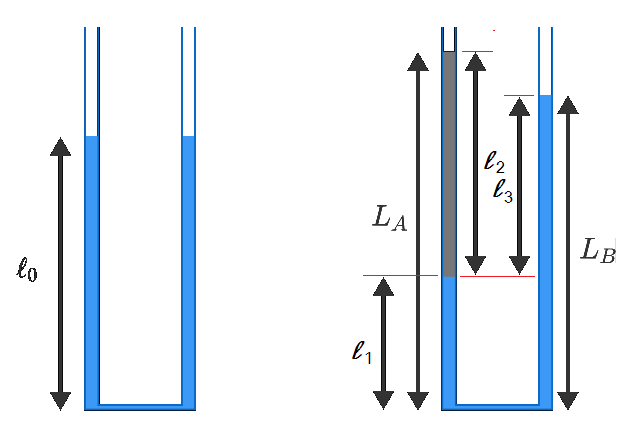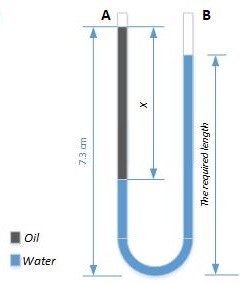U-tube
Initially, the U-tube shown above is filled with water, and the level on each side is ℓ 0 = 5 c m . After some oil is poured on side A , the level on that side becomes L A = 7 . 3 c m .
What is L B ( in c m ) ?
Assume that the water and oil do not mix, and that their densities are related by ρ oil = 0 . 8 5 ρ water .
The answer is 6.7.
This section requires Javascript.
You are seeing this because something didn't load right. We suggest you, (a) try
refreshing the page, (b) enabling javascript if it is disabled on your browser and,
finally, (c)
loading the
non-javascript version of this page
. We're sorry about the hassle.
6 solutions
This isn't related to what you did, but I answered with 6.861 and it counted it as correct. I calculated it as this:
Both columns must have the same mass. But since the oil is 15% less dense, it will require 15% more volume of oil to achieve the same mass as x amount of water. I took off 15% of the length of column A to find the length of column B.
I now saw that I approached very incorectly, as column A is not all oil, as you would assume from the way I set it up. I'm still very confused as to why it counted as correct. Although it is still actuate when rounded, it's still a mistake, and would end up growing to be very large with a scaled up version of this problem.
Log in to reply
density of oil must be given accurately to solve the problem
Now, this is very common mistake. If you decrease density 15% and increase volume 15%, mass will not remain the same! Here is why: 0 . 8 5 ρ ⋅ 1 . 1 5 V = 0 . 9 7 7 5 ρ V so mass decreased 2.25%. Percentage is not additive! +15% and -15% do not give 0%. This is because +15% is actually disguised multiplication by 1.15 and -15% is disguised multiplication by 0.85, which together give 0.9775 or -2.25%. Inverse of -15% is 1 / 0 . 8 5 ≈ 1 . 1 7 6 4 7 or ≈ +17.65%.

Let the column of oil be l 2 , the column of water under the column oil be l 1 in the left arm and the column of water above l 1 in the right arm be l 3 = L B − l 1 .
Since the volume of water is the same before and after the oil is poured in, assuming the cross-sectional area of the U-tube is uniform throughout, we have l 1 + L B = 2 l 0 = 1 0 . . . ( 1 ) .
By Newton's third law , the weight of l 2 of oil equals to the weight of l 3 of water. Therefore, ρ oil l 2 g = ρ water l 3 g , where ρ denotes the density of the subscribed liquid and g the acceleration due to gravity. This implies that l 3 = ρ water ρ oil l 2 = 0 . 8 5 l 2 . . . ( 2 ) .
We also note that l 1 + l 2 = L A = 7 . 3 . . . ( 3 ) .
Then we have:
( 1 ) : l 1 + L B 2 l 1 + l 3 2 l 1 + 0 . 8 5 l 2 = 1 0 = 1 0 = 1 0 . . . ( 4 ) Note that l 1 + l 3 = L B And ( 2 ) : l 3 = 0 . 8 5 l 2
{ 2 × ( 3 ) : ( 4 ) : 2 l 1 + 2 l 2 2 l 1 + 0 . 8 5 l 2 = 1 4 . 6 = 1 0
2 × ( 3 ) − ( 4 ) : 1 . 1 5 l 2 = 4 . 6 ⟹ l 2 = 1 . 1 5 4 . 6 = 4
( 3 ) : l 1 + 4 = 7 . 3 ⟹ l 1 = 7 . 3 − 4 = 3 . 3
( 1 ) : 3 . 3 + L B = 1 0 ⟹ L B = 1 0 − 3 . 3 = 6 . 7
2L2 + L3 = 10 ---- Do you mean 2L1 + L3 = 10?
how did you get L2 = 4 and L1 = 3.3? I am confused how you went from (1) to (2) in the second half of your reasoning. Could you please elaborate?
Log in to reply
I have added in the calculation steps. They are very simple. There is no relation between (1) and (2). I have separated them in paragraph.
The fluid pressure on both sides would be equal for the fluid to settle. Let's assume the height of the water on the left side is x , then x ρ w a t e r g + ( 7 . 3 − x ) ρ o i l g = ( 1 0 − x ) ρ w a t e r g x + ( 7 . 3 − x ) ⋅ 0 . 8 5 = 1 0 − x x + ( 7 . 3 ⋅ 0 . 8 5 ) − 0 . 8 5 x = 1 0 − x 1 . 1 5 x = 1 0 − 6 . 2 0 5 x = 3 . 3 ⟹ L B = 1 0 − x = 6 . 7
It would be highly appreciated if you could explain the Rhs ..
Didn't know how to solve it, but I figured the fluids would equalize so that weight of the column of fluid in A was equal to the column of fluid in B.
Writing out the equation of A-Weight = B-Weight you find that the area and density cancel out leaving you Water-Height-A + 0.85 Oil-Height = Water-Height-B.
You know that the water volume or container volume hasn't changed so Water-Height-A + Water-Height-B = 10cm. You also were given that Water-Height-A + Oil-Height = 7.3cm.
After substitution until only Oil-Height and constants remain, you find it to be 6.7cm.
length of water decreased in left tube = b; intial length of water in left tube =a; length of oil poured =c; L and K are lengths of left and right side of the tube after oil is poured;
L=a-b+c------------(1); K=a+b--------------(2); adding 1 and 2, we get; L+K=2a+c-----------(3); The relation between c and a in densities is c=0.85a; substituting the same in 3 we get; K=2.8c-L=14-7.3; K=6.7 ;
(5 – x) ρ w a t e r + (2.3 + x) ρ o i l = (5 + x) ρ w a t e r
5 – x + (2.3 + x)0.85 = 5 + x
1.15x = 2.3 x 0.85, x = 1.9 cm; so L_B = 5 + 1.9 = 6.9 = 69E-1.
After adding amount of oil the pressure effected by the oil column will be divided equally to the both sides, so the pressure in the side B will be the original pressure plus half of pressure effected by oil column. let X = oil column.
let X = oil column.
Pressure in both sides are equal and pressure = high * density * g (As g is the gravity constant and i will remove it from the calculations as it is equal in both sides)
Pr at A = Pr at B
X ∗ 0 . 8 5 + ( 7 . 3 − X ) ∗ 1 = 5 ∗ 1 + 0 . 5 ∗ X ∗ 0 . 8 5
X = 4
The required length = new pressure at B / water density
= ( 5 ∗ 1 + 0 . 5 ∗ X ∗ 0 . 8 5 ) / 1 = 6 . 7